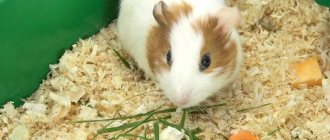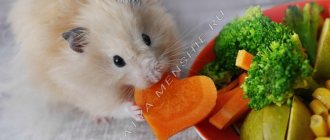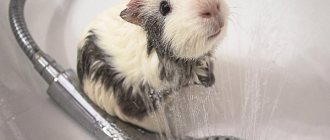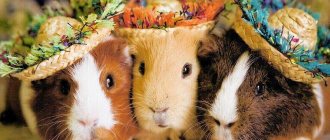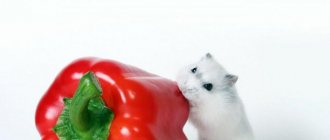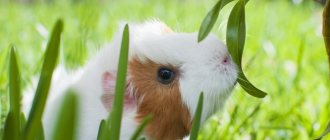Even experienced livestock breeders ask questions: what to feed their pet, whether it is possible to give certain products. Before getting a guinea pig, you should find out which foods will benefit the animal and which may harm its health. A guinea pig's daily menu should include vegetables, fruits, berries and cereals. Many vegetables and fruits can even be offered to your pet along with the peel. It is important to remember that not all foods that guinea pigs eat are equally beneficial for them. What rodents can eat and what they cannot feed a guinea pig is discussed in this article.
What guinea pigs eat: what they can and cannot feed
Keeping guinea pigs at home is very common.
For your pet to live, you need to create comfortable conditions and choose the right food. To ensure normal functioning and maintain health, guinea pigs must be fed food that they could eat in their natural habitat.
In the article we will look at what a guinea pig eats at home, when and what to feed it, what can and cannot be given, a description of food, the diet of pregnant females and newborn babies.
Method for preparing sprouts for pigs
Guinea pigs love green shoots. This is a very useful product for pets. Guinea pig oats can be sprouted even at home. After two weeks, the regrown grass is cut for further growth. Unpeeled oats are used for germination. You can buy it at your local pet store. Sawdust is poured into a shallow container in a small layer. Then they are compacted and oats are sown on top. Water everything with warm water once a day, drain off the excess. Watering should be moderate so that mold does not form and the sprouts do not die. Growing greenery can be cut several times, because she grows back.
What food to give your guinea pig
Guinea pigs eat a variety of foods and greens. According to the recommendations of experienced specialists, the pet’s diet should be varied and balanced. ½ of the total menu should be hay. The remaining 50% of the diet is dry food, succulent food and greens.
Dry food
Dry food includes grain crops and factory-produced granulated mixtures (special food for domestic guinea pigs).
Healthy grain feeds:
- millet;
- barley;
- sunflower seed;
- oats;
- corn grains.
Ready-made mixtures may contain vitamin complexes.
Grains should be in the guinea pig's diet every day and should always be freely available to the pet.
Hay and branches
Hay is the most useful and necessary product for guinea pigs. It improves the functioning of the digestive tract and prevents the development of intestinal diseases, and also helps to grind down the back teeth.
What kind of hay to give your pet:
- fresh, with a natural grassy smell;
- free from dust and other contaminants;
- small bundles (can be pre-cut or rolled into a roll);
- without coarse and large branches.
This food also needs to be given to your guinea pig every day. You can make hay yourself or purchase it ready-made in a store.
Green food
Another important product in the diet of domestic guinea pigs is green food. This is meadow or field grass grown in ecologically clean areas (away from polluted road areas).
Green herbs contain many useful and nutritious substances necessary for the healthy functioning of the body of guinea pigs. In addition, these animals happily eat fresh herbs, as well as equally healthy greens - spinach, dill, parsley, celery, lettuce, etc.
Healthy green food for guinea pigs:
- plantain leaves, dandelion;
- clover;
- cilantro;
- carrot tops;
- yarrow;
- chamomile, etc.
Juicy food
Juicy food for guinea pigs includes fruits and vegetables, as well as some berries, served to the pet as a tasty treat.
What juicy foods can you give:
- beets (fodder, red);
- fresh cucumbers;
- cauliflower and Brussels sprouts;
- carrot;
- Bell pepper;
- tubers and leaves of earthen pear;
- apples;
- garden sow thistle;
- corn cobs;
- zucchini;
- tomatoes;
- grapes (seedless only);
- pumpkin;
- green peas.
As a delicious dessert, you can sometimes pamper your pets with raspberries, wild strawberries, currants, strawberries and tangerines, which are rich in vitamin C.
Treats and vitamins
The body of guinea pigs especially needs vitamin C, so foods rich in ascorbic acid must be present in the daily diet of rodents. Salts and calcium are also important for them. To saturate the body with useful minerals, it is recommended to use special mineral stones from the store.
Healthy treats for guinea pigs:
- dried fruits;
- fruit slices;
- wheat bran;
- fresh cherry branches;
- mint;
- pea pods;
- peeled flax, sesame, pumpkin, sunflower seeds.
Greens and vegetables
Each animal owner independently decides which products from the 4 remaining diets will be the main ones in the daily menu, and which ones will be additional. In this case, it is necessary to take into account the health characteristics of a particular animal. Therefore, it is better to decide on the composition of an individual diet for an animal together with a doctor.
What plants are allowed to be given to a guinea pig?
Guinea pigs are vegetarians. Of course, the animals do not refuse granulated food. This is a convenient, but not the most healthy option for feeding rodents. Natural food is much healthier for animal health.
Many owners of furry pets doubt whether parsley can be given to guinea pigs. This beneficial herb should be present in the diet whenever possible every day. However, given the diuretic properties of the plant, its amount should be limited for pregnant female rodents.
Some owners grow dill and other permitted greens on the windowsill for guinea pigs.
Table 1. Greens that are allowed for guinea pigs
| Name | Features of the composition | Effect on rodents |
| Parsley | Lots of B vitamins, vitamins K, C. | Improves intestinal motility, strengthens the immune system, and reduces stress levels. |
| Dill | Ascorbic acid (132% of the norm per 100 g of product), beta-carotene, folic acid, alpha-tocopherol, vitamins. | Improves appetite, optimizes digestion, increases lactation in lactating females. |
| Cilantro | Vitamins: E, C, B, D. | Stimulates increased appetite, calms the nervous system, and helps strengthen bone tissue. |
| woodlouse | In addition to vitamins and rare microelements, it contains many beneficial essential oils. | Strengthens the immunity of rodents, accelerates intestinal motility. |
| Spinach (leaves) | Lots of iron, calcite, healthy proteins, potassium, phosphorus. | Improves digestion, supports the functioning of the cardiovascular system, strengthens bones. |
| Lettuce (leaves) | Contains potassium, calcium, iron, folic acid, and a high percentage of sucrose. | Normalizes metabolism and digestion, maintains muscle tone. |
| Alfalfa | Lots of proteins, calcium. | Promotes the full development of the musculoskeletal system. It is given fresh without restrictions. Dried alfalfa is given occasionally, in small quantities. |
Important! 100 g of fresh spinach leaves contains over 700 mg of potassium. The plant is extremely useful for strengthening the heart muscle of animals.
The genitourinary system of rodents works in a state of tension most of the day. To strengthen it, you should add yarrow to the pigs' food. The plant has a beneficial effect on the functional activity of the animals' kidneys and significantly improves appetite.
To reduce your guinea pig's blood pressure levels, add fresh or dried nettle to its diet. Due to the diuretic properties of the plant, the animal's urine output slightly increases.
It's no secret that the Achilles heel of guinea pigs is digestion. To help the animals’ digestive system, experienced breeders treat their animals with pink clover from time to time. It is important not to overdo it, because young plants contain a significant amount of cyanogenic glycosides.
If there is too much clover in a guinea pig's diet, it can cause diarrhea.
What grass do guinea pigs not eat?
The fragile organism of a small rodent does not care at all what kind of grass is given to it. The animal’s digestive system reacts to some plants with diarrhea or vomiting. Herbs that contain substances that are poisonous to animals should not be included in the diet.
Table 2. Plants harmful to guinea pigs.
| Name | Effect on rodents |
| Avran | Nausea, diarrhea, intoxication. |
| Hemlock | Contains alkaloids that cause poisoning. The animals' paws go numb, their temperature drops, their heart rate increases, and convulsions begin. |
| Ranunculaceae | Increased salivation, shortness of breath, decreased temperature, development of diarrhea. Attacks of hyperactivity. |
| Datura | Paralysis of the heart and limbs. |
| cornflower | Vomiting, colic, diarrhea, paralysis. |
| Spurge | Inflammation of the gastrointestinal tract, vomiting, diarrhea, cramps. |
| Celandine | Diarrhea, flatulence, general weakness, nausea. |
Important! Garlic and onions contain a lot of phytoncides and have a painful effect on the delicate lining of the pig’s stomach. These plants should be excluded from the rodent menu.
Rules for collecting and processing herbs
For the health of guinea pigs, it is extremely important to use plant materials that were harvested in environmentally friendly areas.
It is prohibited to collect grass for animals where there is:
- industrial facilities;
- busy roads;
- garbage bins;
- dog walking areas;
- waste dumps.
Near fields and vegetable gardens there is a danger of harvesting grass with nitrates and pesticides. It is better to collect plants in open meadows, away from pollution zones.
Important! Freshly washed greens can be offered to animals that are accustomed to eating wet grass. But experts recommend pre-drying washed plants so as not to provoke gastrointestinal disorders in domestic rodents.
Greens that were collected from environmentally friendly areas are not washed. But if there is dust or dirt on the grass, rinse it in warm running water. For winter use, the plants are finely chopped and frozen in plastic bags.
Important! Dry herbs should not be treated with boiling water. High temperature kills microbes, but also greatly reduces the amount of vitamins.
Vegetables
These foods are incredibly important for your guinea pig's health. They are a daily part of the diet of adorable rodents. Zoologists say that animals that are deprived of the required amount of vegetables get sick more often and live shorter lives.
Table 3. Vegetables for guinea pigs.
| Allowed | Prohibited |
| Zucchini, Jerusalem artichoke, ripe eggplant, cucumber, white cabbage, bell pepper, carrots, pumpkin, peas (fresh), rutabaga, beets, turnips. | Potatoes, radishes, radishes, corn kernels, Chinese cabbage. |
Any of the permitted types of vegetables should be given to your pet in small pieces first. If the pig likes the food, next time the amount of product is gradually increased.
Basic rules for feeding rodents vegetables:
- Give foods raw.
- Pre-wash the fruits, scald with boiling water, cut off the hard skin.
- Do not exceed the average daily weight norm (70–80 g, depending on the weight of the animal).
Can guinea pigs have zucchini?
Guinea pigs can be given not only the vegetable itself, but also its leaves - they are very useful for small rodents. Juicy zucchini contains a lot of water with a modified structure. This liquid is extremely beneficial for the digestive system of rodents.
Young guinea pig squash does not need to be peeled; their skin is so delicate that it will not harm the rodent’s stomach.
Cucumber
These vegetables are allowed to be fed to rodents along with seeds. If cucumbers are grown in your own garden, you can give them to guinea pigs along with the skin (not too thick).
Experts recommend including 1 small cucumber in the animals’ diet every day. This vegetable is absolutely safe for animal health, has a neutral taste and is more than 90% liquid.
Important! Salted or pickled cucumbers are prohibited from being included in rodent menus.
Tomato
This vegetable is allowed to be added to rodent food, but in limited quantities. There are animals whose digestive system does not accept this product at all. A lot depends on the individual characteristics of the rodent’s gastrointestinal tract.
If you want to give your guinea pig a tomato, it is important to remember that:
- all green tails of the vegetable must be removed;
- the tomato must be absolutely ripe;
- tomato leaves and stems should not be in the diet of pigs, they are poisonous to animals;
- You can feed your pet tomatoes 3-4 times a week - the animal receives no more than one slice (or 1 cherry tomato) at a time.
You should not get carried away with nightshade plants in the diet of guinea pigs. Unripe vegetables of this family contain substances toxic to rodents.
Is it possible to give guinea pigs cabbage: Chinese cabbage, white cabbage?
When choosing a product for a guinea pig menu, you should give preference to white or red cabbage. These vegetables are a source of fiber, beneficial minerals, vitamins (especially C), and can be given to pigs daily. Cabbage is necessary for animals for physical activity and strong immunity. In addition, the product contains a lot of antioxidants, beneficial amino acids, and beta-carotene.
Most guinea pigs love to crunch on a fresh cabbage leaf. However, you should pay attention to the fiber density of the plant. The pieces of young cabbage in the rodent feeder can be made larger. But if the leaves are harsh, they must be finely chopped before offering them to rodents.
Experts do not recommend giving Chinese cabbage to guinea pigs.
Beet
Experts believe that beets can be given to guinea pigs either raw or boiled. The tails are not removed from the fruit; the peel is not allowed to be peeled.
It is best to pamper animals with juicy beets during the cold season, when the availability of other vegetables is limited. Before use, the root vegetable is thoroughly washed and divided into pieces. Depending on the weight of the rodent, it can be given 50–80 g of product per day. Experienced breeders include beets in the evening feeding of their furry pets.
Important! For guinea pigs, it is better to choose beets that were grown on your own plot, without the use of chemicals. It is also allowed to use farm products.
Bulgarian pepper
You can give bell pepper to guinea pigs, but little by little and not too often. The vegetable contains a large amount of ascorbic acid, carotene, and vitamin C. 20–30 g of product per day is enough for one animal.
Before offering a juicy vegetable to a pig, remove the skin and remove the seeds. Even if the pepper looks clean and beautiful, but was purchased at a chain store, the product must be thoroughly washed.
If pepper is regularly included in the animals’ diet, the pet’s circulatory system will receive a reliable source of support. The substances contained in this juicy product actively strengthen the walls of blood vessels.
Experts advise feeding guinea pigs bell peppers during the seasonal fruiting of this vegetable. This will bring maximum benefits to the health of your furry charges.
Important! Hot and green peppers are prohibited for use in the diet of domestic rodents.
What to feed a pregnant guinea pig and newborn babies
Pregnant rodents need high-quality and nutritious nutrition. Rose hips, which are served to pets in the form of an infusion, are very beneficial for the body. You should also include wheat sprouts, beets and fresh carrots in your daily diet.
The diet of newborn pigs should contain foods rich in vitamins and proteins. For the first two weeks, babies feed on mother's milk. If it is missing, the owner will have to feed the small offspring; it is better to consult a veterinarian for advice.
Already from the second day of life, little guinea pigs begin to try different foods, so it is necessary to ensure that the cage contains:
- Juicy;
- Greens;
- Industrial feed.
Fruits and berries
Bananas
Can guinea pigs have bananas? A banana rich in potassium will benefit your guinea pig, but you should not give more than 1 piece per day.
The peel of the vegetable must be removed, as it is treated with substances hazardous to health (wax, chemicals, ethylene and pesticides). For safety, it is better to remove soft fibers from the fruit.
Can guinea pigs eat a pear?
Pears can be given with the peel, but without the seeds. The fruit is washed well and cut into pieces; the pig should be offered water along with it. Excessive consumption of pears due to their high sugar content can cause diarrhea.
Can guinea pigs eat kiwi?
Kiwi is a very healthy fruit for animals. It contains a large amount of ascorbic and folic acids. It is also rich in vitamins E, iron, calcium, magnesium and phosphorus.
Kiwi is given without skin in the form of small pieces. For your pet, you need to choose harder fruits. It is better to control the amount you eat. An increase in the dose of kiwi is permissible in autumn and winter, as well as when feeding females during pregnancy and lactation.
Can guinea pigs have oranges and other citrus fruits?
Can be used occasionally. But it is better for guinea pigs to get vitamin C from other foods, avoiding citrus fruits. Possible complications:
- oversaturation with vitamins;
- skin irritation;
- oxidation of urine.
Can guinea pigs eat apples?
Apples can be raw or dried. They have a balanced ratio of sugar and fructose (18:80%). It allows the pig to be active.
The fruit must be peeled and cut into slices. It is better not to give more than 3 pieces at a time.
Can guinea pigs eat strawberries, grapes and other berries?
Strawberries contain a sufficient amount of vitamin C to pay attention to the berry when choosing a treat for a rodent. You can also give strawberry leaves to animals.
- The pig might like grapes. You can offer the animal seedless grapes.
- Eating currants once a week will also not harm your pet.
- If you do not abuse it, you can offer the pig berries and raspberry leaves, berries, leaves and branches of blueberries, blackberries and sea buckthorn, and rose hips without seeds.
- Cranberries are given for medicinal purposes. It has an anti-inflammatory effect on the mucous membranes of the mouth, stomach, and bladder.
List of approved products
The diet of guinea pigs is based on foods such as vegetables, fruits, berries, garden and meadow greens, sunflower seeds, seeds, twigs of trees and shrubs.
Healthy and safe food for guinea pigs:
- Vegetables - cucumber, carrots, beets, pumpkin, fennel, zucchini, turnips, parsnips and celery in tubers. In small quantities you can treat your pet to bell peppers, tomatoes, artichokes, cauliflower, rutabaga, and Jerusalem artichoke.
- Fruits - seedless grapes, plums, apples, pears. Bananas, peaches, apricots, watermelon, melon, kiwi, pineapples, oranges and tangerines are served in small quantities.
- Berries - currants, raspberries, blueberries, cherries, sweet cherries, strawberries. In limited quantities - gooseberries, sea buckthorn, blackberries, cranberries, rowan.
- Garden greens - lettuce leaves, dill, celery, sprouted cereal grains, carrot tops, beets, corn cobs. In limited quantities - cilantro, spinach, parsley.
- Meadow greens - nettle, clover, yarrow, alfalfa, plantain, sage, echinacea, burdock, chamomile. Milk thistle, coltsfoot, dandelion, St. John's wort, wormwood, and fireweed are served in small quantities.
- Flax seeds are useful. In limited quantities - sesame seeds, dill, pumpkin and sunflower seeds.
- Useful branches of bushes and trees - birch, mulberry, hazel, pear, raspberry, ash, hawthorn, blueberry, maple and cherry plum. Sometimes you can pamper your pet with branches of chestnut, cherry, aspen, apricot, cherry, willow, poplar and rowan.
- It is not often that a rodent can be fed green peas and asparagus in small quantities.
Green feed
This food for guinea pigs is the most healthy and natural. Your pet should eat fresh greens, rich in fiber and nutrients, to maintain normal functioning of the intestinal tract. Below is a list of herbs recommended for guinea pigs:
- cereal sprouts;
- spinach;
- lettuce leaves;
- clover;
- carrot tops;
- beet tops;
- dill, parsley, cilantro;
- plantain;
- yarrow;
- chamomile;
- dandelion leaves.
You need to be very careful when collecting grass for your pet. Among the useful plants there may be poisonous ones. Therefore, you should not put a bunch of grass in a cage without carefully sorting it out first. Fresh greens for your guinea pig should be thoroughly washed.
What not to feed a guinea pig
There is a list of harmful foods that you should absolutely not feed to your pet guinea pig. They are absolutely useless for their body, and some of them can cause serious health problems.
What not to give to rodents:
- Prohibited vegetables: radish, radish, onion, potato, eggplant, garlic, horseradish.
- Harmful fruits: dates, persimmons, lemon, lime, pomegranates and grapefruits.
- Do not feed your pet sorrel, rhubarb greens, green onions, garlic, as well as lavender, motherwort, celandine, belladonna, serpentine, valerian, wild rosemary, fern, sow thistle and hemp seeds.
- Branches of fir, quince, oak, pine and spruce are prohibited for rodent food.
- Beans and boiled peas should not be given as legume products.
- Meat and dairy products, eggs, sweets and baked goods are prohibited in any form.
It is also unacceptable to give guinea pigs food from your table, low-quality food, spoiled and stale food, indoor greens, canned food, spices, mushrooms and fruit seeds.
Poisonous plants
When going to collect herbs for your beloved pet, you need to remember that there are a number of poisonous plants that not only cause poisoning, but also lead to death.
Plants that are poisonous and dangerous to guinea pigs include:
- Fighter, Arum, White acacia, Common aloe, Common and lemon geranium, All types of ferns, All types of lilies, Sorrel, Nightshade, Henbane, Lilies of the valley, All varieties of narcissus, Hyacinths, Celandine.
The following are considered dangerous for animals:
- Bay leaf, Gorse, All types of wisteria, Yew, All types of ivy, Derain, Common broom, Dogwood and all types of honeysuckle.
It is strictly forbidden to feed the following tree species:
- Twigs of thuja and oleander, Privet, Shoots and roots of juniper, Berries, leaves and twigs of elderberry, Mistletoe, Leaves, shoots and twigs of hellebore and belladonna.
Guinea pig diet
Cereals and pelleted feeds
This type of diet is based on grain crops and ready-made food, containing all the necessary vitamins and mineral supplements for the healthy growth and development of a domestic rodent.
Nutrition Features:
- You need to buy only high-quality food from trusted manufacturers for your guinea pig. Cheap food contains many harmful and unnatural ingredients that can cause serious health problems.
- Dry food must be supplemented with moist, juicy food.
- Clean drinking water should always be freely available to your pet.
- It is not advisable to feed high-calorie foods to inactive rodents.
Advantages of nutrition: ready-made food has a solid structure, which helps the animal grind its teeth, convenient use of food, no need to prepare special food for the rodent.
Disadvantages: you need to constantly purchase food for your pet and always have a certain supply of it in the house.
On our store’s website you can select and buy high-quality industrial food for domestic guinea pigs from reliable global manufacturers. The range includes cozy cages for rodents, comfortable drinking bowls, special toilets with nozzles, various accessories for games and much more.
How to give vegetables to your pet
Often corn is fed to pigs as follows:
- Grain is cut from young cobs.
- The cob is cleaned of the fleecy part.
- Offer a treat to the guinea pig.
Regarding dry grains, it is recommended to give them to pets occasionally, and then as a mixture with other dry products. If your guinea pig frequently eats whole grains, it can cause dental problems; the seeds can get stuck and create discomfort for the rodent. Removing it can damage your jaw. These are not very pleasant consequences, so it is better to limit the consumption of whole grains by animals.
It is important to treat nutrition with such a product wisely so that it is beneficial. It is important to remember that all food must be clean, fresh, suitable for the animal, and without the smell of rot. Giving your pet the same foods every day is considered a bad decision. Thus, the rodent’s body will not develop and function correctly, the animal will be lethargic and unplayful.
Taking into account all the tips regarding feeding guinea pigs corn, you can avoid the digestive problems that so often plague this type of rodent. A balanced diet and a properly formulated diet are the key to a healthy, long and happy life for pets.
Guinea pig feeding
Guinea pigs need to be fed correctly, avoiding overeating and obesity of the pet. The serving quantity is determined by the type of diet and the age of the animal.
Quantity and quality of food
The amount of daily serving of grain-free food is up to 30% of the pet’s total body weight. After feeding, food is removed from the cage. Only hay and young branches of bushes or trees can be left freely available.
One serving of grain food for an adult pet is 1/2 tablespoon. In addition to dry food, you can pamper your rodent with small amounts of pieces of fruit and vegetables.
All food served to a pet rodent must be fresh and of high quality. Under no circumstances should you give your pet spoiled vegetables or fruits. Such food can cause serious poisoning.
The feed dosage is doubled when feeding pregnant guinea pigs. You need to introduce more juicy and green foods into your diet, rich in healthy vitamins and mineral complexes.
How many times a day should you feed your guinea pig?
Grain feeding is served no more than 2 times a day. It is advisable to follow a feeding schedule and give food at the same time. Uneaten dry food may remain in your pet's feeder all the time.
Water
Clean drinking water should always be in your pet rodent's drinking bowl. An adult pet can drink up to 250 ml of liquid per day. Pregnant guinea pigs drink even more water.
Pet rodents should be given filtered or bottled clean water. For convenient and safe storage of liquid in a cage, it is recommended to use a special closed drinking bowl that does not contain dust or other debris. Pathogenic microorganisms that are unsafe for the animal’s body can multiply in contaminated water.
Guinea pigs should not be given any sweet, carbonated or dairy drinks. You can only give your pet regular water and not boiled water!
Source
General feeding rules
For a healthy and well-groomed appearance, you need to feed your guinea pig properly. Your daily diet should look like this:
- 60% hay;
- 30% succulent food and greens;
- 10% dry food.
An adult eats about 150 g of food per day. The basis of the diet is vegetables, which should be given every day. To replenish the body with vitamins, a variety of greens are also added to them. Fruits, berries and nuts are given more rarely.
Eating the same type of food will quickly cause a lack of certain vitamins and nutrients. You cannot feed the same thing day after day. It is recommended to give other foods every day and alternate them with each other. Feed the pet three times a day.
It is important to give your guinea pig only organic food. Her stomach is quite weak and reacts sharply to the chemo. Before including greens in the menu, make sure that they are not rotten or with dew.
Hay is stored in advance. It should be present constantly, especially in winter. Your pet chews it very often. It is necessary for digestion and grinding of teeth. It is recommended to give preference to legume-cereal hay and legumes. Alfalfa, nettle and clover are often dried, which are especially useful for pregnant women and young animals.
